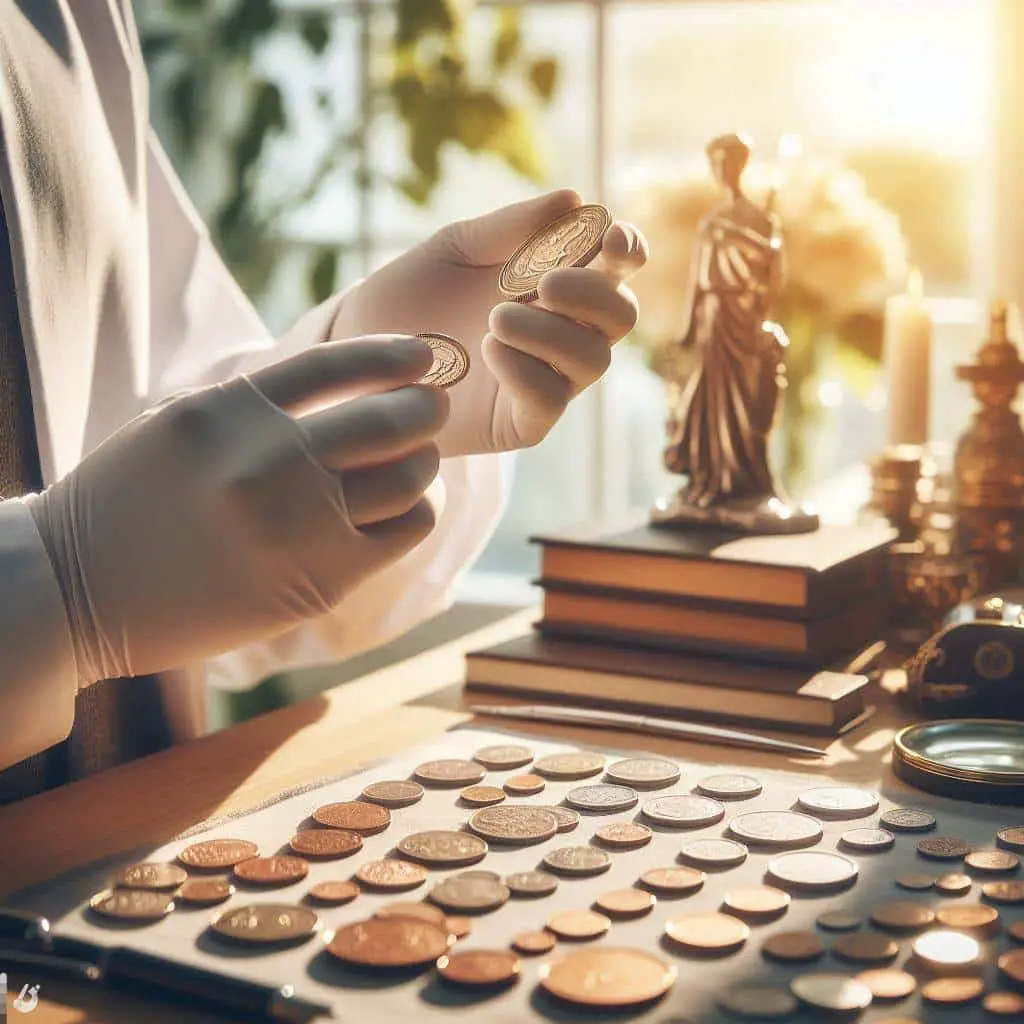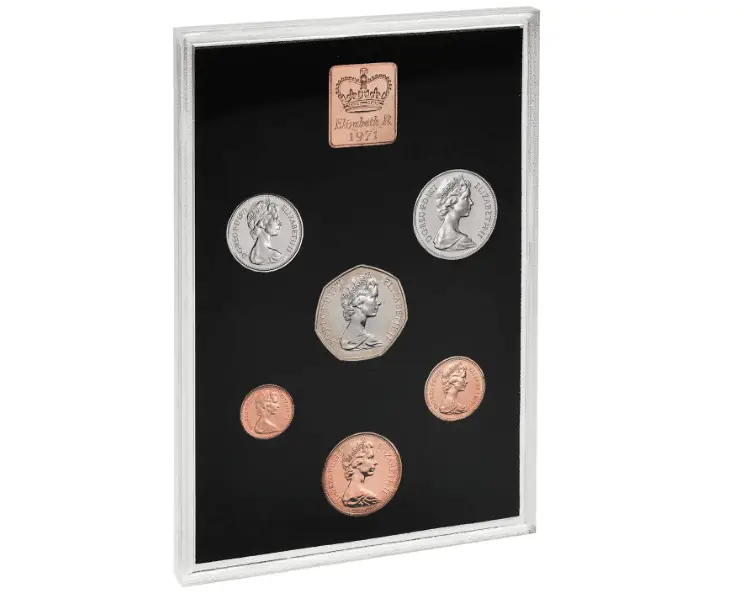On 15 February 1971, the United Kingdom underwent a significant transformation as it carried out the monumental task of decimalising, transitioning from the traditional guineas, shillings, and pence system to a modern decimal currency system. Decimalisation in the UK in 1971 marked a pivotal moment, initiating a new era where the pound divided into 100 new pence, simplifying transactions and bringing the UK in line with global currency standards. This overhaul was not an overnight decision; it resulted from years of planning. The Royal Mint played a crucial role in ensuring the readiness of millions of new coins, heralding this change with the introduction of coin denominations such as the 5p and 10p coins preceding Decimal Day.
Understanding the value and significance of the first ever decimal coin set requires delving into the historical roots and examining the profound impact of when the UK went decimal. The article aims to explore the components of the 1971 proof set, the Royal Mint’s role, the factors influencing the value of these coin denominations, and the current market trends. A comprehensive review, this piece seeks to shed light on the intricate matrix of historical, economic, and collectible facets that continue to define the worth of the decimal coin set, an enduring symbol of the UK’s stride towards financial modernisation.
Historical Context
The transition to decimalisation in the UK in 1971 marked a pivotal moment in British numismatic history, fundamentally altering the currency system from the ancient pounds, shillings, and pence (lsd) to a simplified decimal format. This monumental shift was encapsulated in the 1971 UK Proof Annual 6 Coin Set, a significant collection that includes:
- 1971 Elizabeth II Proof Fifty Pence
- 1971 Elizabeth II Proof Ten Pence
- 1971 Elizabeth II Proof Five Pence
- 1971 Elizabeth II Proof Two Pence
- 1971 Elizabeth II Proof One Pence
- 1971 Elizabeth II Proof Halfpenny
The Royal Mint crucially distributed these coins, which featured a mix of three bronze and two cupro-nickel denominations and were the first to be introduced in preparation for Decimal Day. Notably, a Royal Blue plastic folder accompanies the set, which contains a description sheet offering collectors both context and educational value regarding the history of these coins.
The journey towards decimalisation was long and fraught with hesitations. Initially, the British currency system, dating back to Roman times, consisted of 12 pennies to the shilling and 20 shillings to the pound. Despite considering decimalisation as early as 1824, Britain’s transition was delayed due to the introduction of the two shilling silver florin in 1849 and the double florin in 1887. The establishment of the Decimal Currency Board (DCB) and a comprehensive public information campaign prepared the nation for the switchover on Decimal Day, 15 February 1971. In the lead-up, the introduction of new 5p and 10p coins in 1968 mirrored the size and value of the one and two shilling coins, while a new 50p coin replaced the 10 bob (shilling) note in 1969.
The decimalisation process
The decimalisation process was meticulous, with banks closing for four days prior to the changeover to process outstanding transactions and convert account balances.
Currency converters made available, and shops implemented dual pricing to ease the transition. The public adapted to the new system as the old and new currencies operated concurrently for a short period. During this adjustment period, the introduction of new coin designs occurred, such as the 1971 1p coin featuring a crowned portcullis on the reverse and the inscription “NEW PENNY,” which later changed to “ONE PENNY” in 1982. The Royal Mint issued a staggering 1,521,666,250 1p coins in 1971, highlighting the scale of the decimalisation effort. The 1971 UK Proof Annual 6 Coin Set not only represents this historical milestone but also serves as a testament to the UK’s journey towards financial modernisation.
Components of the 1971 Proof Set
Delving into the components of the 1971 UK Proof Annual 6 Coin Set reveals a meticulously crafted collection, emblematic of the monumental shift to decimal currency. Each coin in this set is struck to a proof standard, showcasing the pinnacle of the Royal Mint’s craftsmanship during this pivotal period. The components of this set, along with their specifications, are as follows:
1971 Elizabeth II Proof Fifty Pence:
Cupronickel, 30mm, 13.5g, featuring the iconic Seated Britannia design by Christopher Ironside.
1971 Elizabeth II Proof Ten Pence:
Cupronickel, 28.5mm, 11.31g, adorned with a lion passant guardant, part of the crest of England, also by Christopher Ironside.
1971 Elizabeth II Proof Five Pence:
Cupronickel, 23.6mm, 5.66g, showcasing a thistle royally crowned, representative of Scotland, designed by Christopher Ironside.
1971 Elizabeth II Proof Two Pence:
Bronze, 25.9mm, 7.13g, featuring The Badge of the Prince of Wales, a plume of three ostrich feathers within a coronet, by Christopher Ironside.
1971 Elizabeth II Proof One Pence:
Bronze, 20.3mm, 3.56g, displaying a crowned portcullis with chains, an adaptation of the Badge of King Henry VII, by Christopher Ironside.
1971 Elizabeth II Proof Halfpenny:
Bronze, 17.1mm, 1.78g, featuring a representation of St Edward’s Crown by Christopher Ironside.
The 1971 UK Proof Annual 6 Coin Set is meticulously presented in a double-sided clear plastic case within a decorative card envelope, maintaining its originality from the mint. Complete with a descriptive card and the Royal Mint medallion, this set offers historical context and educational value. Despite potential toning, typical for sets of its age, each piece retains its uniqueness. Comprising cupronickel, bronze, and nickel-brass, with standard specifications for the era, the collection authentically reflects the UK’s transition to decimal currency. Its significance extends beyond numismatics, serving as a tangible connection to British history. With its thoughtful packaging and historical importance, this set holds appeal for collectors and enthusiasts alike.
Factors Influencing Value
Understanding the factors influencing the value of the 1971 UK Proof Annual 6 Coin Set and individual coins such as the 1971 1p requires a detailed examination of several elements. These factors not only help in assessing the worth of these collectibles but also debunk common misconceptions about their market value. Here’s a breakdown:
- Misconceptions and Reality:
- Despite rumors, a 1971 1p coin is not valued at £35,000. The actual market price for such a coin is approximately £1, including postage, debunking the inflated value myth.
- Real Value Enhancers:
- True value enhancers are rare errors found in coins, including:
- Off-center strikes
- Wrong planchets
- Mule errors (coins struck with mismatching obverse and reverse designs)
- These errors can significantly increase a coin’s value, with notable examples being the 1933 Penny, some 1983 2p coins, and the bronze 1992 1p.
- True value enhancers are rare errors found in coins, including:
- Appraising and Valuing Coins:
- When valuing coins on platforms like eBay, it’s crucial to:
- Filter for coins that have actually sold
- Consider the average selling price, as outlier listings may not accurately represent the market
- The value of the 1971 UK Proof Annual 6 Coin Set is influenced by:
- Age and rarity of the set
- The type and condition of coins included
- Consulting a competent appraiser, such as a reputable coin shop, is advisable for an accurate valuation, ensuring enthusiasts and collectors understand the true worth of their items.
- When valuing coins on platforms like eBay, it’s crucial to:
These factors collectively contribute to understanding the true value of decimalisation UK 1971 coin sets and individual coins, providing enthusiasts with a reliable guide to assessing their collections.
Current Market Trends for UK 1971 Proof Sets
In the evolving market of numismatics, the 1971 UK decimal coin set stands as a beacon for collectors and enthusiasts alike, offering a tangible slice of British monetary history. The accessibility and affordability of these sets make them an appealing option for a wide range of collectors, from beginners to seasoned numismatists. Here’s a closer look at the current market trends for these iconic sets:
Standard 1971 UK Decimal Coin Set:
Price: Available for purchase at approximately £10.00, this set is an attractive entry point for those looking to own a piece of history.
Value Proposition: Collectors seeking to expand their collection without breaking the bank can acquire the set for around 10 or 11 pounds, making it a good value proposition due to its commonality.
Versatility: Beyond its appeal to collectors, the 1971 UK decimal coin set serves as a fantastic nostalgic gift, ideal for numismatics enthusiasts, and finds utility in educational settings, arts, and crafts projects.
1971 UK Annual Proof Coin Set:
Price: Priced at £22.00 (Special Scheme Inc. VAT), this set offers a higher tier of collectibility due to its proof quality coins, appealing to those looking for finer specimens of the 1971 decimalisation coins.
50th Anniversary of Decimal Changeover Proof Coin Set:
Components: This commemorative set includes fourteen coins, all struck in proof quality by the Royal Mint, and features the coveted Royal Mint medallion dated 1970, adding to its collectible value.
Price: With a price tag of £249.00, this set targets the more serious collector or those looking to commemorate the 50th anniversary with a significant piece.
Guarantee: Accompanied by a no-quibble 365-day money-back guarantee, this set not only promises quality but also offers peace of mind for the purchaser.
Market trends for the 1971 UK Proof Sets and special commemorative editions indicate a spectrum of options catering to diverse interests and budgets within the numismatic community. Collectors have a variety of options to choose from to celebrate and own a piece of the UK’s decimalisation history. Whether they opt for the standard decimal coin set priced at a modest £10.00, the Annual Proof Coin Set available at a mid-range price, or the premium 50th Anniversary of Decimal Changeover Proof Coin Set, these offerings present collectors with a range of choices, from affordable entry points to premium commemoratives. This ensures that the legacy of Decimalisation UK 1971 continues to be appreciated across generations.
Conclusion
In reflecting on the journey and significance of the UK’s transition to decimal currency in 1971, it becomes clear that the event was more than just a change in monetary units; it represented a profound shift in the financial landscape of the nation. The 1971 UK Proof Annual 6 Coin Set not only encapsulates this historical turning point but also offers collectors and history enthusiasts alike a tangible connection to a moment that reshaped Britain’s economic future. The meticulous curation and the enduring value of these coin sets underscore the Royal Mint’s dedication to commemorating a pivotal moment in British history, allowing individuals to own a piece of this monumental change.
The broader implications of decimalisation, its impact on the numismatic field, and the current market trends for the 1971 proof sets highlight not only the historical importance but also the ongoing interest and value found within these collections. Whether for the seasoned collector, the enthusiastic beginner, or those intrigued by Britain’s rich monetary history, the 1971 decimal coin sets offer a unique opportunity to explore and appreciate the legacy of the UK’s financial modernisation. As we continue to navigate the evolving landscape of currency and collectibles, the story of Decimalisation UK 1971 and its commemorative coin sets remain an invaluable part of our collective economic and historical narrative.

